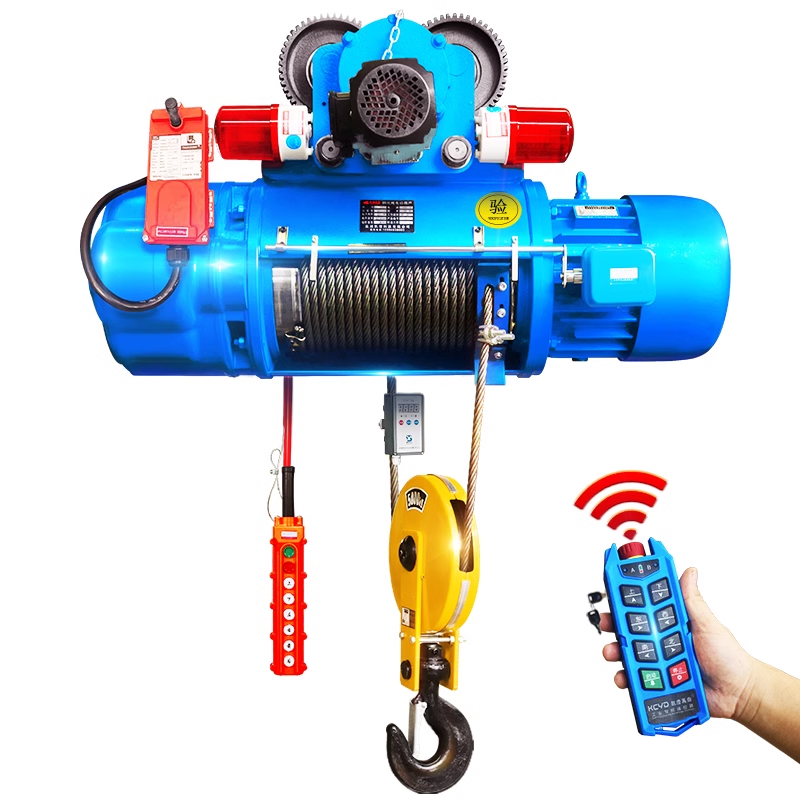What are the advantages of an electric hoist with a trolley?

As an efficient and convenient lifting equipment, electric hoists play a vital role in modern industrial production and logistics transportation. The electric hoist with a trolley, featuring its unique structural design, further expands its application scenarios and flexibility.
The Perfect Combination of Flexibility and Efficiency
1.Dual Capability of Vertical Lifting and Horizontal Movement.
An electric hoist with a trolley combines the vertical lifting function of a hoist and the horizontal mobility of a trolley. Driven by a motor, the hoist can traverse laterally along I-beam tracks or custom-designed rails, enabling precise material positioning in three-dimensional space. This dual functionality significantly reduces manual handling time and operational risks.
2.Modular Design for Versatile Adaptability.
By adopting a split design between the trolley and hoist, the system supports customizable configurations of varying tonnage capacities and span lengths. This modularity ensures flexible adaptation to workshop retrofitting or production line upgrades, enabling seamless scalability based on operational needs.
Load Capacity Range: Full Coverage from Light-Duty to Heavy-Duty Applications.
1.Load Capacity of Standard Models
- Light-Duty: 0.25t-5t, suitable for lightweight operations in small workshops, laboratories, and similar environments.
- Medium-Duty: 5t-20t, covering most manufacturing and warehousing needs.
- Heavy-Duty: 20t-100t, primarily used in metallurgy, shipbuilding, and other heavy industries.
2.Key Factors Affecting Load Capacity
- Track Material and Span: The specifications of I-beam tracks directly determine the maximum load capacity.
- Motor Power: High-tonnage applications require high-power motors and reinforced braking systems.
- Structural Design: The double-girder hoist with trolley exhibits greater load capacity and superior stability compared to single-girder configurations.
3.Customized Solutions for Special Scenarios
- Ultra-Low Headroom Design: Suitable for height-restricted workshops with a load capacity up to 10 tons.
- Coordinated Dual-Trolley Operation: Enables balanced hoisting of overweight loads through a synchronized control system.
Selection Guidelines: Core Criteria for Requirement Matching
1. Define Operational Scenarios: Consider ambient temperature, explosion-proof requirements, operational frequency, and related factors.
2. Calculate Load Demands: Include maximum lifting capacity, movement frequency, and additional dynamic load coefficients.
3. Track Parameter Compatibility: Select tracks based on span lengths and implement steel structure reinforcement when necessary.
Applicable Scope: Covering Multiple Industry Scenarios
1.Manufacturing and Assembly Workshops: Automotive, machinery manufacturing, and related sectors, utilized for component hoisting on production lines and equipment installation.
2.Electronics Industry: Precise handling and positioning of sensitive instruments to minimize vibration impacts on products.
3.Warehousing and Logistics Centers: Integrated with rack systems to achieve three-dimensional storage and retrieval of goods, optimizing warehouse space utilization.
4.Construction and Maintenance Sector
- Plant Maintenance: Installation and replacement of HVAC units and pipelines.
- Bridge Inspection and Repair: Utilizing mobile track systems to facilitate heavy-duty tool hoisting.
5.Metallurgical and Chemical Industries
High-Temperature and Explosion-Proof Electric Hoist Trolleys: Suitable for deployment in high-temperature furnace zones or hazardous material workshops.
Electric hoists with trolleys, leveraging their integrated vertical and horizontal movement capabilities, have become pivotal equipment in modern industries for enhancing operational efficiency and reducing labor costs. With ongoing intelligent upgrades, the application scope of these systems is poised to expand into new operational frontiers.














